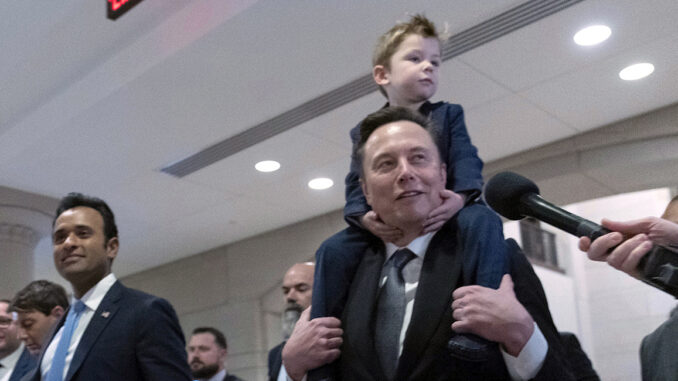
The whole debate over whether the Department of Government Efficiency (DOGE) is needed can be summed up in three words: Yes, it does.
Ask yourself the following questions and then see if the answers below make sense to you as a layman citizen:
“If we were starting the USA all over again today, what would we want our government to do? More importantly, what would we NOT want our government to do?”
No one ever asks those questions. How will we know where we want to go unless someone can define the goal we want to achieve?
The answers will determine which programs are, by definition, not important and can be reduced or eliminated. (The private sector calls this “zero-based budgeting.” Small businessmen and entrepreneurs call it “survival”)
Keep the defense department? Yes, please. The most important part of our government.
However, 10-20% of spending could be saved if DOGE can get Republicans to vote to discontinue defunct, redundant services that they, and many Democrats, have refused to do since World War II. More than $1.8 trillion in defense spending alone can be saved over the next decade by adopting the recommendations in the invaluable ― but seldom read ― CBO document “Options for Reducing the Deficit.”
Get a copy and read it over the holidays ― you will be one of only a handful of citizens, including members of Congress and senators, to have ever read the whole thing in history.
Social Security should be separated from the unified budget and operated as a stand-alone retirement/pension fund entity. The “size” of the federal government would automatically fall 21% in terms of outlays, but 29% of overall tax revenue in the form of Social Security payroll taxes would go with it as well.
At least then, improvements and reforms to Social Security can be made in the vacuum of debate about retirement security without being caught up in the Sturm und Drang of the rest of democratic politics.
Jonathan Felts discusses implementing a nationwide Social Security reform based on the federal Thrift Savings Plan, which could be offered as a way to transition Social Security to a more modern financial vehicle for everyone.
Medicare and Medicaid make up the bulk of the rest of the budget except for the $1 trillion in interest paid on our enormous existing debt. Medicaid has already been transformed into a managed care system nationwide, which has provided better care to Medicaid patients at an overall lower cost than under the typical fee-for-service plans. Medicare should come under the managed care network umbrella as well in the next decade to avoid bankruptcy.
Every other program in the federal budget should be put on the president’s impoundment list in a power given to him by the 1974 Budget and Impoundment Act. There’s about $1 trillion in discretionary spending outside of defense, so there could be a series of 10 “reverse appropriations” bills (RABs), let’s call them, introduced at $100 billion apiece and then force Congress — on a line-by-line budget function basis — to vote on which rescissions to keep and which presidential recommendations to override.
Every Democrat will vote to cut defense programs recommended by CBO, so President Donald Trump and DOGE would only need a few Republicans to save about $1 trillion there. Cutting domestic programs will be much more difficult since, to be bluntly honest, a lot of Republicans don’t like to cut spending in any budget function. There would have to be all sorts of odd combinations of coalitions cobbled together on each of the 10 RABs to get any sort of a significant reduction of 10% in all of them.
But if they do, another $1 trillion in wasteful spending could be saved over the next decade.
Before anyone gets too excited, consider this: If all DOGE can accomplish are these spending reductions named above, they will just barely “pay for” the extension of the Trump tax cuts, which have to be voted upon by the end of 2025.
Think about that ― all of these dramatic spending cuts have to be enacted just to avoid massively increasing our national debt way more than under current law.
If Trump and the Republican-led Congress will cancel or reverse all the irresponsible spending by President Joe Biden on student loan forgiveness and green new deals, it will only be then that the level of $1.8 trillion annual deficits starts to move slowly down. Hopefully, by 2034, annual deficits will be “only” $500 billion per year instead of $2 trillion.
The challenge ahead for DOGE is enormous and daunting at the same time. It is time for Republicans to step up and act like Republicans again.


